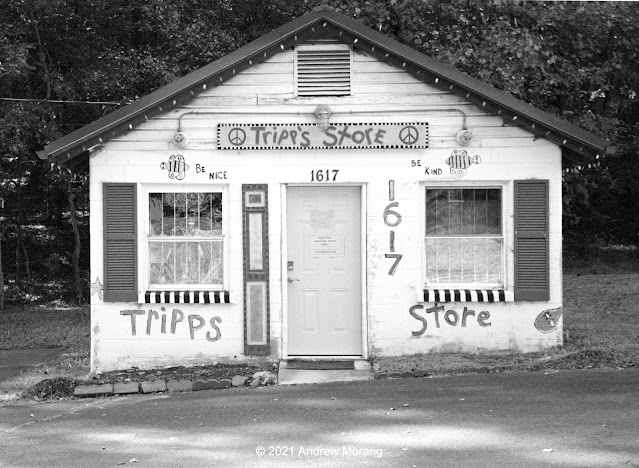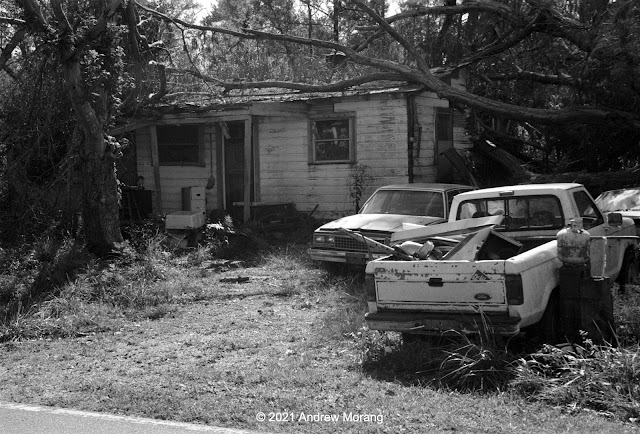This will be a short review of my new/old Jupiter-8 50mm ƒ/2 lens from the Soviet Union. It was made for use on Soviet thread-mount cameras, like the FED, but uses almost the same 39mm thread as the original Leica bodies as well as most Japanese post-war rangefinder cameras.
 |
| Jupiter-8 lens mounted on my 1949-vintage Leica IIIC camera |
 |
| Coated front element of Jupiter-8, probably 1962 construction (note: scratch-free and clear) |
Many film photographers love the rendition from the classic Zeiss Sonnar 50mm ƒ/2 lens. Dr. Ludwig Bertele at Zeiss Ikon, the German optical giant, first formulated this lens in 1929. The name comes from the word “Sonne,” meaning Sun. Zeiss sold it with their magnificent Contax rangefinder camera in the 1930s and later. This competed with Ernst Leitz's popular Leica thread-mount cameras when equipped with their 5cm ƒ/2 Summar lens or the later 7-element ƒ/2 Summitar lens.
After WWII, the Soviets packed up and moved remnants of the Zeiss factories, tools, machinery, glass, and technicians to the Soviet Union and painfully began to rebuild their home optical industry. They largely copied the Zeiss optical designs but made minor changes over the years and coated the glass surfaces to reduce flare. They renamed these new lenses Jupiter (ЮПИТЕР). The 50mm ƒ/2 version is the ЮПИТЕР-8. They produced these lenses from the early 1950s until about 1991, when the Soviet economy collapsed. The Jupiter-8 was the standard lens on many Zorki, FED, and Kiev cameras, which were made in the millions. The Soviet lenses had aluminum mounts instead of the superior brass/chrome mounts of the older German production. The Internet is full of detailed reviews of the Jupiter-8, so I will not repeat the same material.
Recently, the Lomo company reintroduced the Jupiter-3, which is the 50mm ƒ/1.5 model. Note that Zeiss still sells a modern ƒ/1.5 Sonnar lens, an amazing testament to a long-lasting design (but the current lens is significantly different then the original).
Eighty years after the original design, photographers still like the way the Sonnar reveals details on film. Original 1930s and 1940s German examples are seriously expensive. As an alternative, I decided to try a Jupiter-8 and found one from a seller from Arizona. He said he bought it decades ago along with a set of Soviet thread-mount cameras. Arizona - that suggests dry and no fungus. This one was a Version 2 (
design PT3060) from 1962 production (earlier is better for Soviet optics). The lens was clean and the coating almost perfect, but it was need of re-lubricating, as do almost all of these old Soviet optics; after all, they are 50+ years old.
This lens uses a filter mount thread of 40.5mm. This was common for German lenses in the post-war era. I already had a 40.5mm Series VI filter adapter, allowing me to use my Series VI filters. Note that some Japanese lens makers used a filter diameter of 40.0mm for their ƒ/2 or ƒ/2.8 rangefinder lenses. Why did they do that? Was it to sell brand new filters and accessories to buyers of Japanese lenses? Yes, of course!
Here are some Jupiter examples around town, both when mounted on a digital camera and when used with film on my
Leica IIIC camera.
Digital
I attached the Jupiter-8 to my Fuji X-E1 digital camera using a Leica thread mount-Fuji-X adapter. On all of these scenes, I set the Jupiter at ƒ/5.6 and mounted the camera on a tripod to eliminate vibration. This digital camera has an APS-size sensor, so a 50mm lens provides a field of view similar to a 75mm lens on a 35mm camera. Click any frame to expand to 1600 pixels wide.
 |
| Approaching storm, Kansas City Southern rail yard, Levee Street, Vicksburg (ƒ/5.6) |
 |
| After the storm, Levee Street, Vicksburg |
 |
| Kansas City Southern rail yard from the Yazoo Canal levee, ƒ/5.6 |
 |
| Washington Street view north |
 |
| Pine Street cottages photographed from Belmont Street |
 |
| Work shed on Yazoo Canal levee (no longer extent) |
Panatomic-X Film
I loaded Kodak
Panatomic-X film in my
Leica IIIC. I thought it appropriate to expose an old-fashioned film in an old camera body mounting an old lens. The package proved to be compact and convenient to use, but I do wish the Jupiter had click-stops on the aperture control. I exposed the Panatomic-X at EI=20, so most photographs required a tripod. I used a Gossen Luna Pro Digital light meter in incident mode for most measurements.
 |
| Sondheimer, Louisiana (1/10 ƒ/11.5, medium yellow filter, tripod-mounted) |
 |
| 1101 N. Chestnut Street, Tallulah, Louisiana (1/10 ƒ/8.0) |
 |
| PoBoy Don's, LA 602 east of Tallulah, Louisiana (1/100 ƒ/4.0, hand-held) |
 |
| Footbridge from Avenue B over Stouts Bayou, Vicksburg, Feb. 15, 2021 (1/10 ƒ/11.5) |
 |
| Acadia Place, Vicksburg, Feb. 15, 2021 |
 |
| Kansas City Southern rail tracks at Maloney Circle, Vicksburg National Military Park (1 sec. ƒ/16) |
 |
Fairground Street Bridge (¼ sec ƒ8; click to see 2400 pixels)
|
Fuji Acros 100 Film
 |
| Old bus, Moseley Gap Road, Vicksburg (¼ sec. ƒ/16) |
 |
| Ford Fairlane, Mt. Alban Road, Vicksburg (1/10 sec. ƒ/11.5) |
I also finished a roll of Fuji's superb Acros 100 film with the Jupiter-8 lens. Being an ISO 100 film, it is easier to use out in the field than the slow Panatomic-X film (but the examples above are tripod-mounted).
Kodak BW400CN Film
 |
| Tripp's Store, Mount Carmel Road, Chapel Hill, North Carolina |
 |
| Barn off Greensboro-Chapel Hill Road, Snow Camp, North Carolina (1/100 ƒ/11.5, yellow filter) |
 |
| Greensboro-Chapel Hill Road, near Snow Camp, North Carolina |
I have mixed feelings about Kodak BW400CN film. For these scenes, it worked well. At other times, it looks grainy and gritty. Possibly it does not age well. Regardless, I have used up my last three rolls and will not search for any more.
Comments and Summary
This old Jupiter-8 is a nice lens, and I like the results on both a digital camera and on black and white film. I think it sings with film. I do not see any obvious barrel or pincushion distortion, and exposure is even across the frame. At apertures wider than ƒ/5.6, this lens is quite weak, and sharpness falls off at the corners. On the scale of web pictures, the falloff is barely visible. I do not see (or do not know what to look for) the unique Sonnar rendition in these examples, but my photography friend in the UK said the special magic is at ƒ/2. This Jupiter has less field curvature then my 1949 Leitz Summitar lens.
The Jupiter has an aluminum body, which is conveniently light weight. The finish is not up to German or Japanese standards, but at least on my sample, the numbers are perfectly legible. No issues.
Many photographers have written about focus shift with Sonnar lenses. I have not seen it yet, but have not taken close-focus photographs at wide aperture. This lens and my Summitar both focus perfectly at infinity using the same Leica-Fuji X adapter on my Fuji X-E1. Therefore, I assume that the Jupiter-8 is correctly adjusted for infinity on a Leica thread-mount camera. Close-up, it may back focus a bit, but I will need to test some more (one day in my non-spare time). UPDATE: I sent it to Mr Brian Sweeney, a Soviet lens expert in the USA, for a cleaning and adjustment for correct focus on Leica cameras.
I have also used one of the superb 1960s
Canon 50mm ƒ/1.4 lenses. The Canon was more uniform across the field and may have displayed marginally better resolution. The mechanical construction was
much better, typical Japanese excellence and precision from the 1960s. Its downside for me was the size of the overall optic. It blocked too much of my viewfinder of my little Leica, and the auxiliary 50mm finder was clumsy.
In summary, the Jupiter-8 lens works well and has a nice rendition on film and digital. It is conveniently compact. When I use my little IIIC camera, I just may end up taking both the Jupiter and Summitar 50mm lenses in my camera kit.

























































